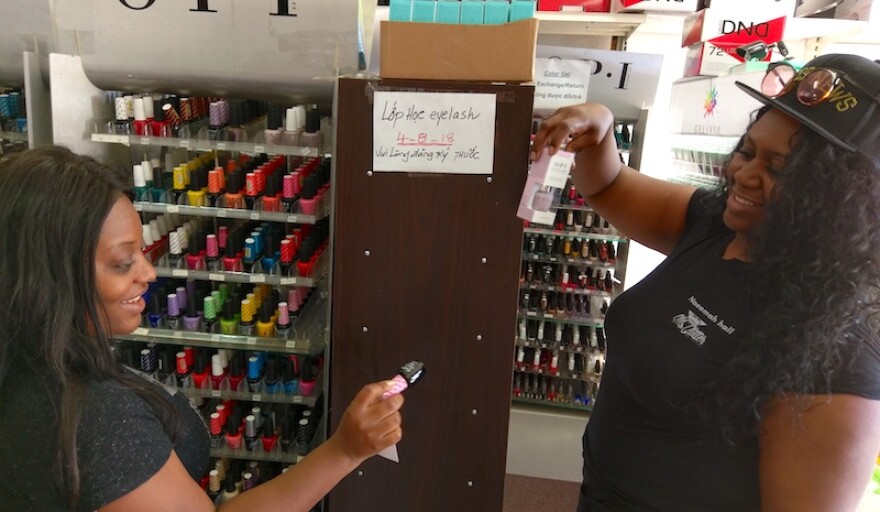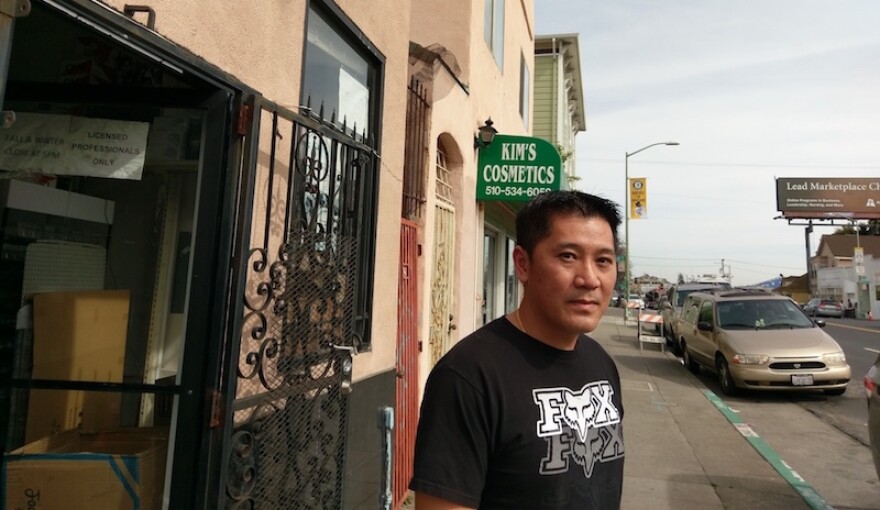A massive, multi-year transit project is transforming International Boulevard in Oakland — and financial aid for local businesses affected by the project is tangled up in red tape.
In November, we reported that some business owners on International Blvd. are worried that construction of a 9.5 mile express bus line stretching from downtown Oakland to San Leandro will disrupt the neighborhood and force them to close.
Dan Keller, who lives on International Boulevard in the Eastlake neighborhood, is a fan of the $217 million Bus Rapid Transit (BRT) project, which aims to improve transit and reduce car use by creating dedicated bus lanes, and bus stops that look more like light rail stations. After hearing the story, Keller wrote in to Hey Area, our community journalism project, asking: “Was any of that money available to help local businesses navigate the changes actually spent, and if so how?”
Waiting for help to arrive
Allen Nguyen owns a cosmetics shop in the San Antonio neighborhood, at International Blvd. and 20th Ave. His store, Generation Beauty Supply, sells bulk supplies at volumes that would be inconvenient for a bus trip.
When the new “Bus Rapid Transit” line is built, it will squeeze car traffic along International into a single lane, and eliminate much of the parking in front of Nguyen’s store.
Nguyen asked the city to help him relocate the entrance to his business, so customers could come park in the back.

But after years of back-and-forth with an ever-changing cast of city officials and contractors, Nguyen says he’s unclear if any assistance is on its way.
“To this day I really don't know which branch or who to call in the city,” says Nguyen. “It was always someone new, and after I tried to call that person and they were like, ‘Oh sorry, I got switched to a different department,’ or so on.”
In 2016, the City of Oakland approved a “Business Sustainability Program” to help businesses that would be permanently impacted by the BRT. According to Susana Villarreal, the program’s manager, contractors for the city have given business advice to more than 400 merchants affected by the BRT line.
That includes Generation Beauty Supply. The city’s contractors worked with Nguyen to apply for a grant to expand his driveway. But Nguyen is still waiting for the money, and he’s not clear where his application stands.
“It's been three years since we asked for help,” says Nguyen. “We shouldn't approach a situation where the water is up to our nose before we react.”
City acknowledges a “slow start”
AC Transit, which will operate the BRT system, reports budgeting almost $20 million to address the needs of businesses along the route. The bulk of that sum goes to changes in public infrastructure, like adding parking, relocating utilities, and improving pedestrian facilities.
A smaller portion, $4 million, goes to Oakland’s Business Sustainability Program to directly help businesses that will be affected permanently by the bus system. The program itself has two components: $2 million to provide advice and consulting to business owners, and another $2 million grant fund for businesses that need to make substantial changes, like relocating a driveway.
“We haven’t spent one cent yet” of the grant fund, says Villarreal, the program manager.
In fact, allocation of that money is at least a year behind schedule. The fund was approved in July two years ago. Half of it comes from federal money that was meant to be spent by June 2017.
Villarreal says challenges enrolling businesses led to the spending delays. Store owners need to demonstrate valid business licenses, and their construction plans must meet city code.
She says some merchants who expressed interest eventually decided not to apply for funding.
In the case of Nguyen’s cosmetics shop, his original request ran into some trouble with building codes.
Nguyen “will get the help move the driveway,” says Villarreal, “but the other things that he wanted on the side door cannot happen,” due to fire regulations.
Money to relocate
Vicente Soto works just half a block away from Nguyen. He sells and repairs large household machines at his shop, V & A Appliances.
Refrigerators, clothes dryers, and kitchen stoves sit out on the sidewalk. Customers pull over on the street to load the appliances onto pickup trucks. There’s no other parking for clients.
“They’re going to put a station here in front,” said Soto, speaking in Spanish. There won’t be enough sidewalk space to maneuver the machines into his shop.

So he asked the city to help him to relocate the business.
After months of consulting and paperwork, Soto is in line to get $100,000 from the city to help buy a new building on International, further down into East Oakland. When that money arrives, Villarreal says he will be the first business owner to receive a grant from the $2 million fund.
“Unfortunately, it took off to a slow start, and we're really looking forward to a faster one this year,” says Villarreal.
Villarreal says sixteen businesses are in line to get grants this year. Next year, more than a hundred businesses could get support.
But that’s on a street with more than 1,000 businesses total.
Schedule delays depleting city funds
Like the business-assistance grant program, construction on the BRT is also a year behind schedule. AC Transit has not confirmed a date for when construction will begin on Nguyen’s block. He still has some time to prepare and adjust.
But Villarreal says AC Transit’s construction delays also mean that the city’s budget for assistance is being stretched thin. The city’s contractors have already been paid for a year of work, and more lies ahead.
“That’s going to be a challenge because the [BRT] project is very much overdue and it could be delayed,” says Villarreal.
Robert Lyles, Media Affairs Manager for AC Transit, wrote in an email that “the technical assistance teams and support are not tied to construction,” and that the delay in launching technical assistance was “created by the city of Oakland.”
Lyles says that the bus rapid transit system will start carrying passengers in late 2019.
“I'm crossing my fingers and hoping that the city actually hurries up with the process so that we could get some help before the BRT project actually starts,” says Nguyen.
“It’s great to have BRT, it's great to have easy public transportation,” he adds. “But you’ve got to look back at who you stomped on, or who you just crushed just to get this project going.”
This question came to KALW through Hey Area, a crowdsourced, collaborative reporting project. Got a question for Hey Area? Ask it below.







